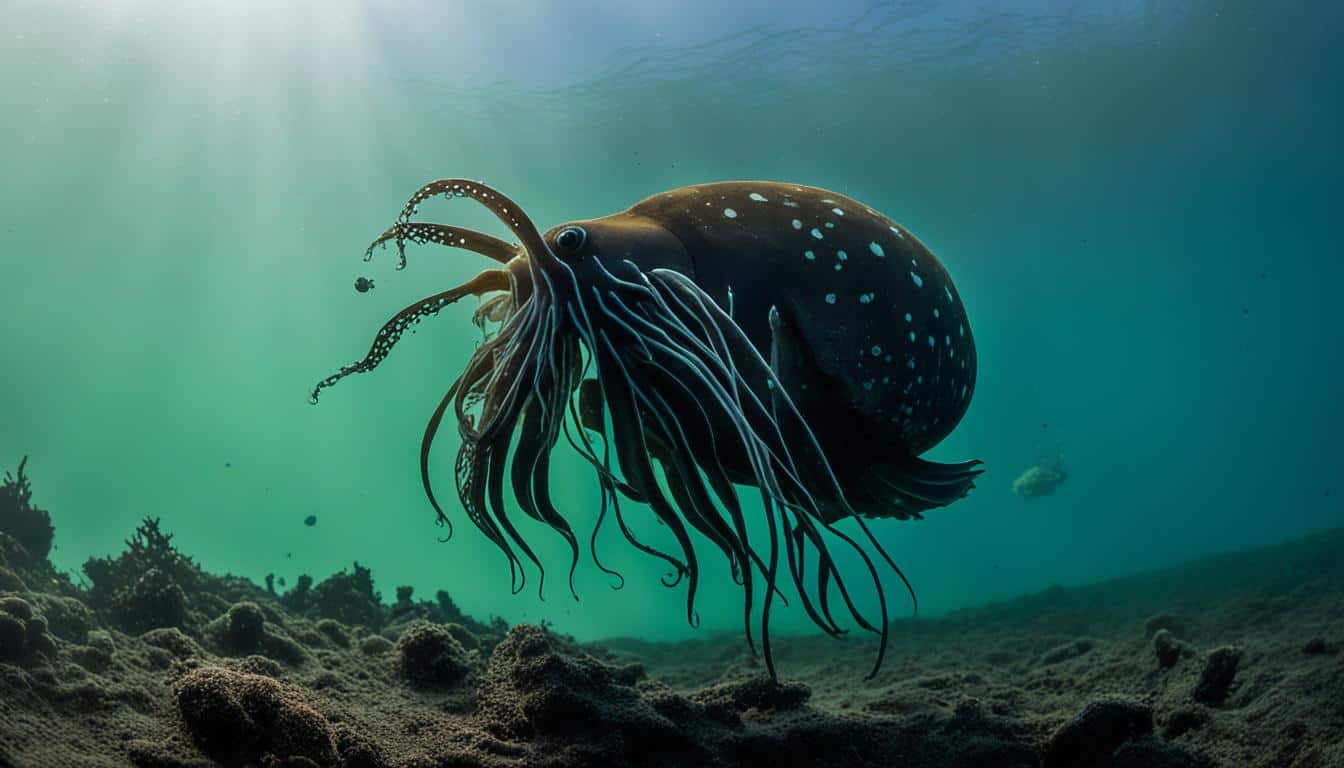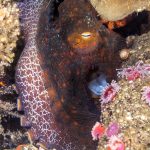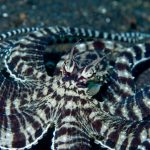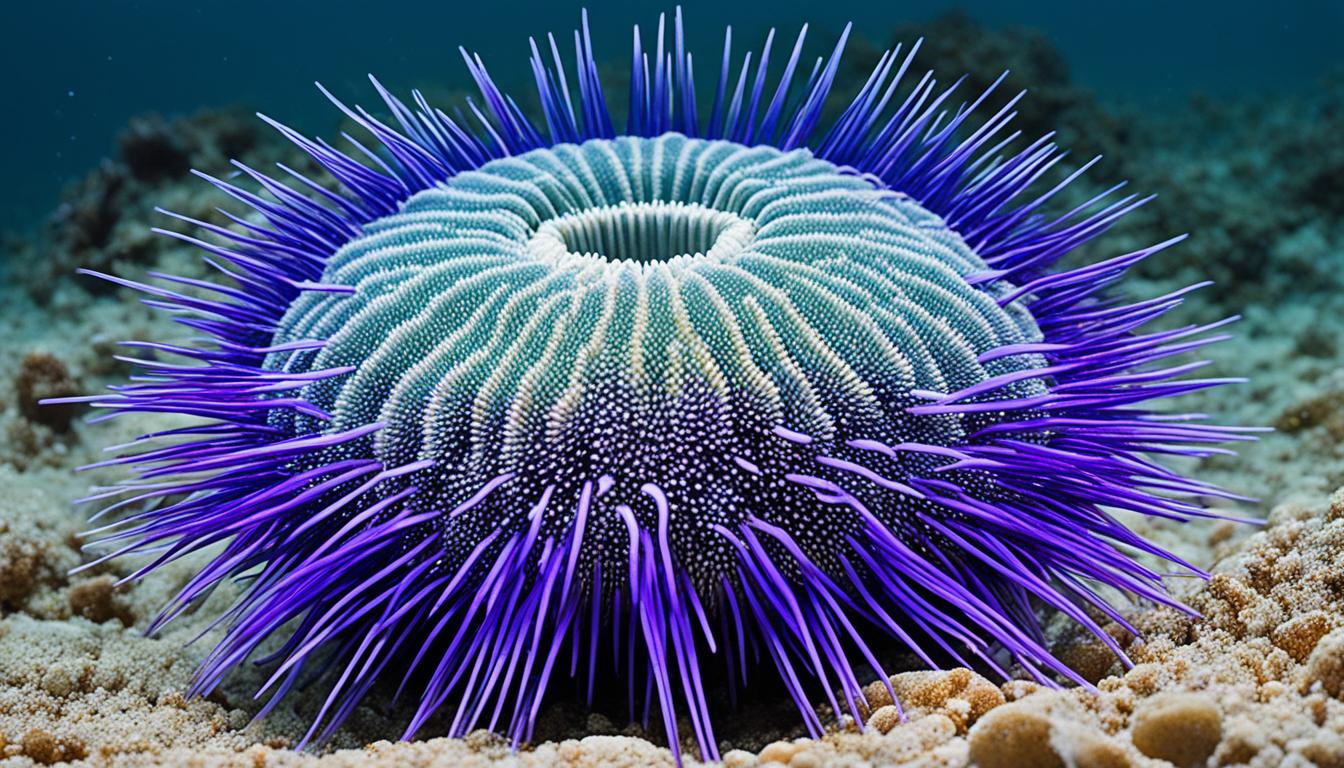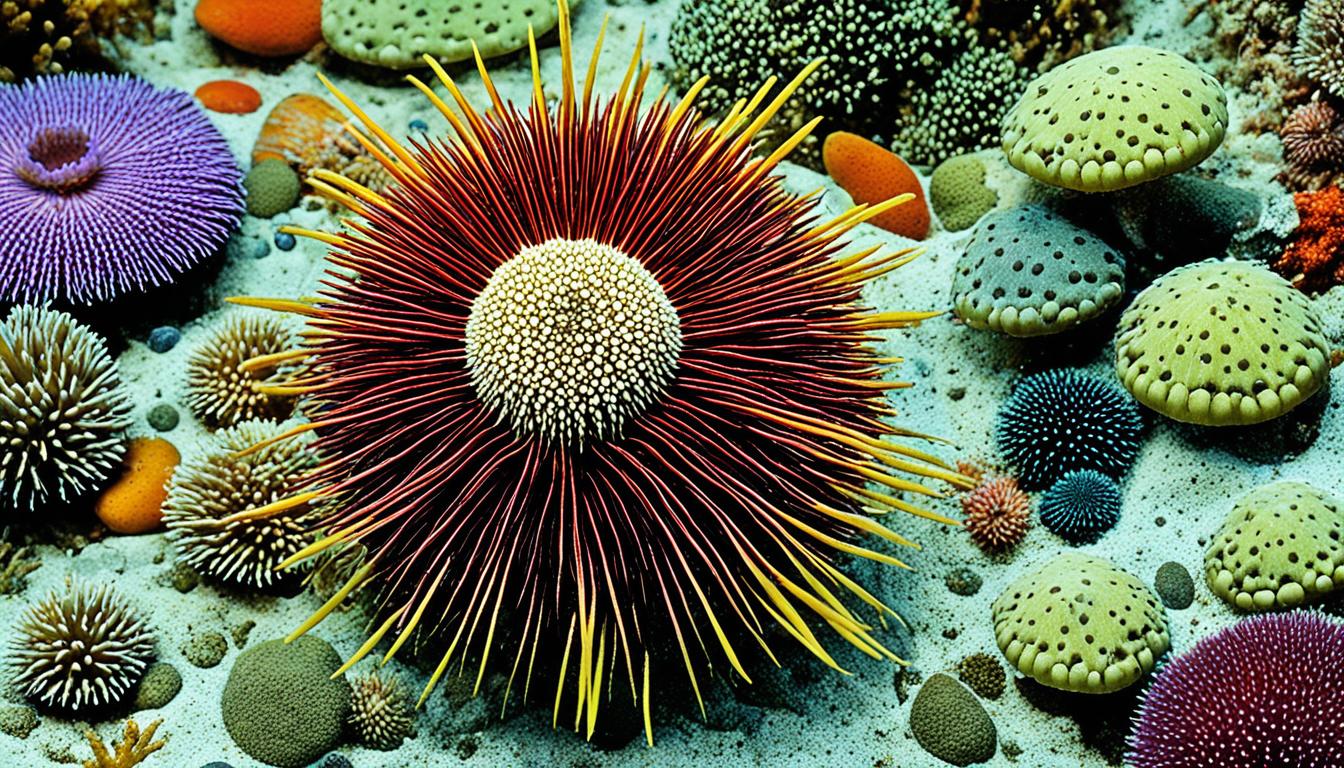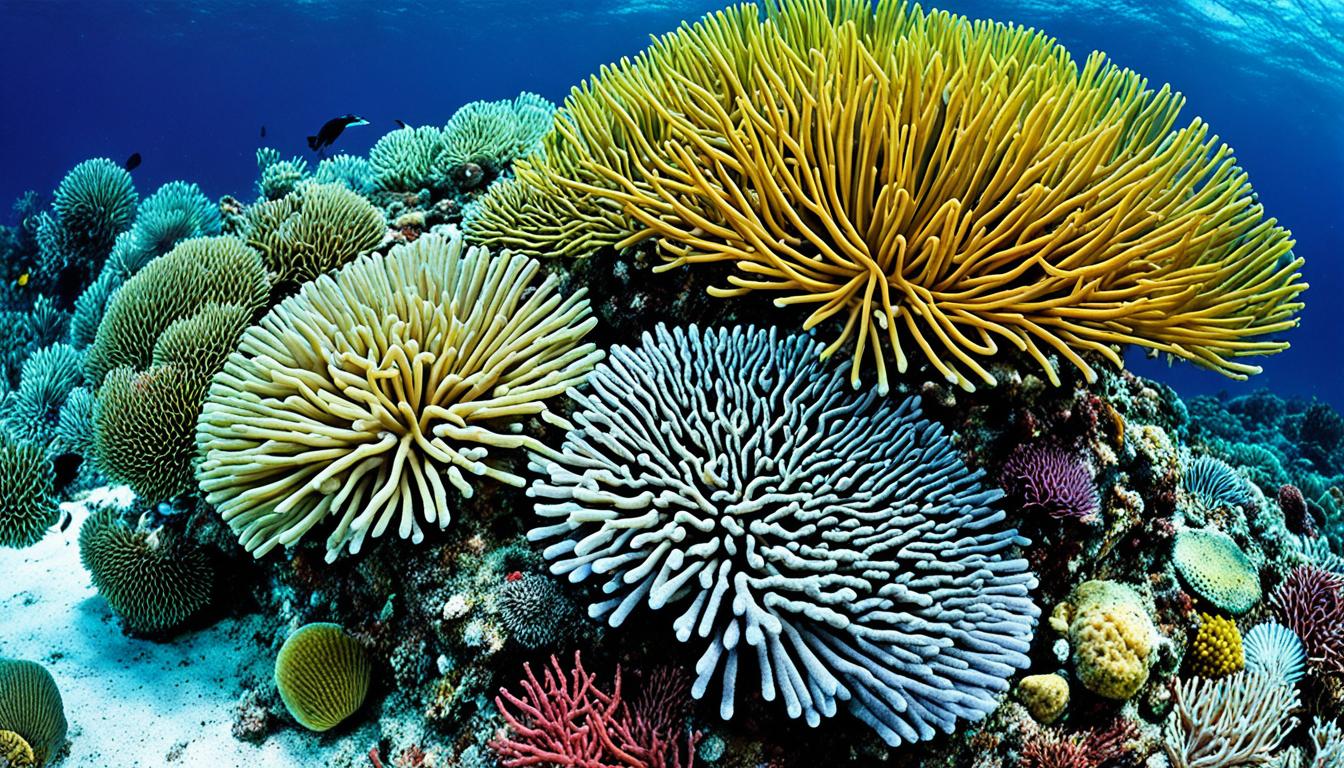Cuttlefish are amazing sea hunters that belong to the cephalopod family. They have a special way of hunting that includes sharp vision, blending in, and quick moves. This makes them skilled predators in the ocean. Let’s dive into their hunting skills to learn more about their role in the sea and how they’ve adapted over time.
As we look into how cuttlefish hunt, you’ll see the key methods they use. These strategies help them survive and succeed in their underwater world.
Cuttlefish Hunting Behavior
Cuttlefish have amazing hunting skills thanks to their sharp instincts. They can see well even in dim light, which helps them hunt at any time. The type of prey and the environment affect how they hunt, showing how adaptable they are.
Understanding the Predatory Instincts
Cuttlefish are smart hunters with great skills. They can read their surroundings well, picking the best way to catch their prey. This flexibility lets them catch a wide range of prey, from small fish to crustaceans, in different places.
Role of Camouflage in Hunting
Camouflage is key to how cuttlefish hunt. They can change their skin color and texture fast, blending in perfectly. This skill helps them surprise their prey and protects them from other predators. It shows how closely cuttlefish are connected to their environment.
| Hunting Aspect | Details |
|---|---|
| Vision | Optimized for low-light conditions, enhancing prey detection. |
| Predatory Instincts | Adaptable strategies based on prey type and environment. |
| Camouflage | Rapid skin changes for ambush and predator evasion. |
| Prey Diversity | Cuttlefish feed on a variety of organisms, including fish and crustaceans. |
How do cuttlefish hunt?
Cuttlefish have a unique way of hunting that ensures they catch their prey. Their hunting process can be broken down into three main steps. Each step is crucial for their success in catching food.
The Three Distinct Phases of Hunting
The first step is attention. Cuttlefish use their special eyes to spot potential food. They gather important details about the prey’s movement and size. This step is key to their hunting plan.
Next, they move into the positioning phase. Here, they slowly get closer to their prey. They stretch out their tentacles with great care, ensuring they don’t scare the prey away. This careful approach helps them get close without being noticed.
Then, in the striking phase, they act fast. Cuttlefish can shoot out their tentacles at speeds of up to 2.5 m/s. This quick action helps them catch their prey efficiently. Their hunting process, from attention to striking, shows how effective they are at catching food.
Techniques of Cuttlefish Hunting
Cuttlefish are amazing hunters, using different methods for their prey. Their hunting skills are key to catching food. They change their tactics based on the prey’s movement and type.
Efficiency in Prey Capture
Cuttlefish are great at catching prey quickly and accurately. For fast prey, they use quick tentacle strikes. For slower or still prey, they slowly wrap their arms around it.
They also use “Tentacle Shot Patterns” (TSPs) to distract before striking. This makes them better at catching prey. It shows how cuttlefish are skilled hunters in the sea.
| Technique | Description | Prey Type |
|---|---|---|
| Rapid Tentacle Strike | Quick strike with tentacles for agile prey. | Fast-moving species |
| Gradual Approach | Slow encirclement with arms for stationary targets. | Slower-moving species |
| Tentacle Shot Patterns | Visual distractions to enhance capture chances. | Various prey types |
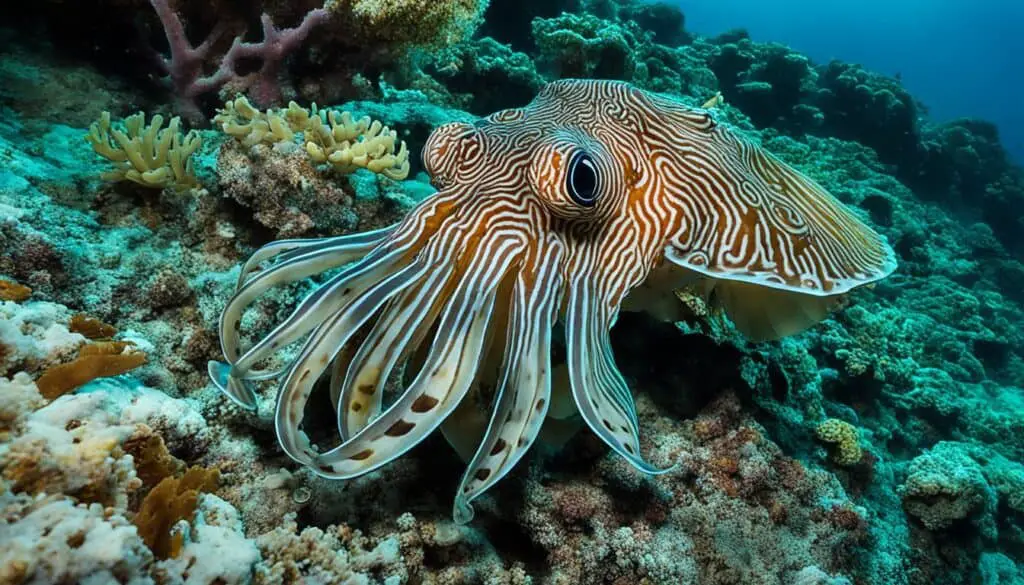
Cuttlefish Prey Capture Strategies
Cuttlefish show amazing flexibility in how they catch prey, changing their methods with the light around them. They adjust their hunting ways to fit different underwater places. This shows how smart they are at catching food in many environments.
Adaptations for Different Light Conditions
In the daytime, cuttlefish use their great eyesight to find food from far away. They can see well in bright light, making hunting more direct and successful. At night, they use their amazing camouflage skills. They hide well and can see in the dark to catch food by surprise.
This ability to change is key for cuttlefish, as they live in many places and eat different foods. Their hunting ways change from day to night, showing how they work with their surroundings. This shows the complex link between a hunter and its environment.
Predatory Habits of Cuttlefish
Cuttlefish play a big role in the ocean’s food chain. They eat small fish, crustaceans, and other sea creatures. Their hunting ways show how important they are to the ocean’s balance.
They have smart hunting tricks that depend on the size and speed of their prey. They also change their hunting based on the environment. This makes them great at catching food in different places.
One cool thing about cuttlefish is how they can hunt in different ways. They can chase prey or wait quietly for the perfect moment to attack. This flexibility helps them catch food in many situations.
Also, cuttlefish can change how they hunt based on what’s happening around them. This helps them hunt better and keeps the ocean’s balance. Learning about their hunting ways shows us how complex ocean life is and why they’re so good at it.
FAQ
How do cuttlefish hunt their prey?
Cuttlefish hunt in three steps: attention, positioning, and striking. They use their sharp eyesight, camouflage, and fast moves to catch their prey off guard.
What role does camouflage play in cuttlefish hunting behavior?
Cuttlefish change their skin color and texture quickly to hide. This helps them sneak up on prey and stay hidden from predators.
What are the techniques of cuttlefish hunting?
Cuttlefish have different hunting methods for different situations. They use quick tentacles for fast-moving prey and a slow, sneaky approach for slower targets. Their “Tentacle Shot Patterns” make them better hunters.
How do cuttlefish adjust their hunting strategies based on light conditions?
Cuttlefish change how they hunt with the light. In the day, they use their sharp vision. At night, they rely on camouflage and their night vision to find food.
What are the predatory habits of cuttlefish?
Cuttlefish eat small fish, crustaceans, and other sea creatures. They hunt in ways that depend on the number of prey and their surroundings. They switch between chasing actively and ambushing quietly.

